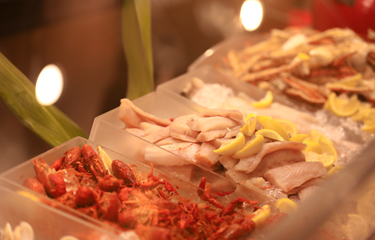US restaurants, casinos forced to pull crab, other species

Seafood is being pulled from restaurant menus across the United States as it becomes too difficult – or expensive – to source.
Nearly every premium item – from lobsters and scallops to king crab and snow crab – is hard to come by these days. And prices on most items have risen at least 50 percent in the past quarter, according to Kristian Wade, executive chef at the MGM Resorts-owned Beau Rivage Resort and Casino in Biloxi, Mississippi.
As the country emerges from the COVID-19 pandemic, the surging U.S. economy is facing supply-side squeezes from a tight labor market, shortages and rising prices for materials, and transportation issues. As a result, there simply is not enough king and snow crab available to buyers, Wade SeafoodSource.
In Biloxi, which is home to several major casino operators, most casinos have stopped carrying Alaskan king crab legs on their buffets. Restaurants that are serving boiled king crab legs are charging around USD 40 (EUR 34) per pound retail in some cases. Instead of king and snow crab, the resort has switched to blue crab, which is still pricey at USD 40 (EUR 34) per pound wholesale.
Atlanta, Georgia-based eatery Iberian Pig is paying as much as USD 44 (EUR 37) per pound for blue crab, a 140 percent increase over the past few months, the restaurant’s chef, Josue Pena, told Bloomberg. Pena was forced to remove the restaurant’s popular Crab Croquettes dish from the menu, along with scallops and halibut, which has soared from USD 16 (EUR 13) to USD 28 (EUR 24) per pound wholesale throughout the pandemic, he said.
“The price we had to charge to be profitable was almost insulting,” Pena said.
Chefs from New York to California have also had to pull scallops from their menus, they told Bloomberg. The wholesale cost of finfish and shellfish has risen 18.8 percent since last June, according to the Bureau of Labor Statistics. Dungeness crab prices at the boat have doubled, and halibut and black cod prices have soared as well.
“We are having trouble getting everything from calamari to West Coast oysters,” Wade said. “Same with scallops and mussels; We are not able to get much of anything right now.”
North American lobster prices has spiked as well. Lobster inventory has declined since COVID-19 restrictions in Canada last summer reduced boat crews going out to sea for prime-season catching, Sysco told Bloomberg.
Restaurant buyers haven’t been able to fall back on South African lobsters, which are currently unavailable, according to Wade. “We are pulling some from Western Australia, but there is not much of that product out there.”
Maine Lobster Dealers' Association Executive Director Annie Tselikis told SeafoodSource it all comes down to supply and demand – and right now, demand is sky-high.
“The pandemic is a huge driver. It’s the fact that people are out and restaurants are open,” Tselikis said. “You add on top of that that people have basically been holed up for a year-and-a-half, and they’re out and looking to celebrate and they’re doing that with great products like lobster.”
As a result of higher prices on upscale seafood items, prices on tuna and other finfish have also risen because buyers are switching to more of those items, Wade noted. As a result, top-quality tuna has doubled in price from the first quarter to the second quarter of this year, reaching around USD 40 (EUR 34) per pound wholesale, according to Wade.
However, Beau Rivage is “still buying what our guests expect, and the quality they expect,” Wade said.
“Regardless of cost, we’ve got to do the right thing,” Wade said.
Inflation is a big concern for the seafood industry, which hopes to keep alive the unprecedented interest in the category that emerged during the COVID-19 pandemic, according to Santa Monica Seafood President and CEO Roger O’Brien.
“Very few products are not going up in price,” O’Brien told SeafoodSource last month.
Photo courtesy of RYO Alexandre/Shutterstock






Share